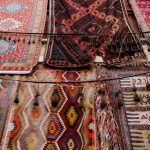Are you wondering which fabric is best to line your denim? Look no further! In this article, we’ll explore the pros and cons of different lining fabrics, including cotton, polyester, silk, rayon, linen, and flannel.
We’ll help you make an informed decision, whether you prioritize breathability, warmth, budget-friendliness, or sheer luxury.
So grab a cup of coffee, sit back, and let’s dive into the world of denim lining fabrics.
Table of Contents
Pros and Cons of Different Lining Fabrics
There are pros and cons to using different lining fabrics for denim.
When it comes to cotton vs silk lining, cotton is a popular choice due to its affordability and breathability. Cotton linings keep you cool and comfortable, making them ideal for warmer climates. However, they may not be as durable as silk linings and can wear out faster.
On the other hand, silk linings are luxurious and provide a smooth and comfortable feel against the skin. They are also more durable than cotton linings and can withstand frequent wear and tear. However, silk linings tend to be more expensive and may not be as breathable as cotton linings.
Now, let’s talk about rayon vs linen lining.
Rayon linings are lightweight and have a soft and silky texture. They drape well and provide a smooth finish to the garment. However, rayon linings are more prone to wrinkling and may not be as durable as linen linings.
Linen linings, on the other hand, are known for their strength and durability. They are breathable and provide excellent moisture absorption, making them suitable for hot and humid climates. However, linen linings may have a rougher texture compared to rayon linings.
Cotton Lining: Is It the Best Choice
When considering the choice of lining fabric for your denim, it’s important to explore alternatives to cotton and weigh the pros and cons.
While cotton lining is commonly used due to its breathability and softness, there are other options worth considering such as polyester, rayon, or even silk, each with their own unique benefits.
Understanding the pros of cotton lining, such as its ability to absorb moisture and its durability, can help you make an informed decision for your denim project.
Alternatives to Cotton
One alternative to cotton for lining denim is polyester. Polyester is a synthetic fiber that offers several advantages over cotton. It is durable, wrinkle-resistant, and has excellent shape retention, making it a popular choice for lining fabrics. However, there are some cons to using polyester. It is not as breathable as natural fibers like cotton, which can make it uncomfortable to wear in hot weather. Additionally, polyester is derived from non-renewable resources and is not biodegradable, contributing to environmental concerns. On the other hand, natural fibers like cotton have their own benefits. They are breathable, soft, and hypoallergenic, making them a comfortable choice for lining denim. Furthermore, cotton is a renewable resource and biodegradable, making it an environmentally friendly option.
| Pros of Synthetic Alternatives | Cons of Synthetic Alternatives | Benefits of Natural Fibers |
|---|---|---|
| Durable | Less breathable | Breathable |
| Wrinkle-resistant | Non-renewable resource | Soft |
| Excellent shape retention | Not biodegradable | Hypoallergenic |
| Environmental concerns | Renewable resource | |
| Biodegradable |
Pros of Cotton Lining?
If you want a comfortable and breathable lining, cotton is a great choice. The benefits of using cotton as a lining for denim are numerous.
Firstly, cotton is a natural and hypoallergenic material, which means it is gentle on your skin and less likely to cause irritation or allergic reactions. Additionally, cotton is highly absorbent, wicking away moisture and keeping you dry and comfortable. It is also a durable fabric, able to withstand regular wear and tear without losing its shape or integrity.
However, there are a few drawbacks to consider. Cotton may shrink when washed and can wrinkle easily, requiring regular ironing. It is also prone to fading over time, especially when exposed to direct sunlight.
Despite these drawbacks, cotton remains a popular choice for lining denim due to its comfort and breathability.
Polyester Lining: Worth Considering
If you’re looking for a lining fabric that offers durability and easy care, polyester lining is worth considering. Polyester is known for its strength and resistance to wrinkles, making it a practical choice for garments that need to withstand everyday wear and tear.
However, if you prefer a more natural option, there are alternatives to polyester lining such as cotton, silk, or rayon that offer different qualities and aesthetics.
Pros of Polyester Lining
You’ll love how polyester lining adds durability and moisture-wicking properties to your denim project. Here are some pros of using polyester lining:
- Durability: Polyester is known for its strength and resistance to wear and tear, making it an excellent choice for lining denim garments.
- Moisture-wicking: Polyester has moisture-wicking properties, meaning it can help to keep you dry by drawing moisture away from your skin.
- Easy to clean: Polyester is machine washable and dries quickly, making it a convenient option for lining fabric.
- Affordable: Polyester lining is often more budget-friendly compared to other lining fabric options.
When choosing the right lining fabric for your denim project, consider the pros and cons of polyester lining. While it offers durability, moisture-wicking, easy cleaning, and affordability, it may not provide the same breathability as natural fibers. Ultimately, the choice depends on your specific needs and preferences.
Alternatives to Polyester
When considering alternatives to polyester lining, it’s important to explore options that offer similar durability and moisture-wicking properties. If you are looking for sustainable options, natural fiber alternatives are a great choice. Not only are they eco-friendly, but they also provide excellent breathability and comfort. Here is a table comparing some popular options:
| Fabric | Durability | Moisture-Wicking |
|---|---|---|
| Cotton | High | Yes |
| Bamboo | Moderate | Yes |
| Hemp | High | Yes |
Cotton is a widely used natural fiber that is known for its durability and ability to wick away moisture. Bamboo is another sustainable option that has gained popularity due to its softness and moisture-wicking properties. Hemp, on the other hand, is a highly durable and versatile fiber that offers excellent moisture-wicking capabilities. These natural fiber alternatives provide a more sustainable and environmentally friendly choice for lining denim.
Silk Lining: Luxurious but Practical
Silk lining is a luxurious and practical choice for lining your denim. It offers a combination of durability and style that is hard to find in other fabrics. Here are four reasons why silk lining is the perfect option for your denim:
-
Luxurious feel: Silk is known for its soft and smooth texture, which adds a touch of luxury to your denim. It feels great against your skin, making your outfit more comfortable and enjoyable to wear.
-
Durability: Despite its delicate appearance, silk is surprisingly strong and durable. It can withstand regular wear and tear, ensuring that your denim stays in good condition for a long time. This makes silk lining a reliable choice for those who want their denim to last.
-
Breathability: Silk is a natural fiber that allows air to circulate, keeping you cool and comfortable even on warmer days. This breathability factor is crucial when it comes to lining your denim, as it prevents you from feeling suffocated or sweaty.
-
Enhanced style: Silk lining adds an element of sophistication and elegance to your denim. It elevates the overall look of your outfit, making it suitable for both casual and formal occasions. The smooth surface of silk also helps your denim glide on effortlessly, giving you a polished and refined appearance.
Rayon Lining: A Budget-Friendly Option
If you’re looking for a more affordable option, rayon lining is a great choice to consider. Rayon is a synthetic fabric made from cellulose fibers, making it a cost-effective alternative to pricier lining materials like silk. One of the main advantages of rayon lining is its affordability. It allows you to achieve a polished and finished look without breaking the bank.
Rayon also has a smooth and lightweight texture, which adds to its appeal as a lining fabric. However, like any fabric, rayon lining comes with its own set of pros and cons. On the positive side, rayon lining is breathable and moisture-wicking, which makes it suitable for lining garments that may come in contact with the skin. Additionally, rayon has good draping qualities, allowing it to enhance the overall shape of the garment.
When comparing rayon lining to other budget-friendly options such as polyester or acetate, rayon stands out for its natural feel and appearance. It mimics the look and feel of silk, offering a more luxurious touch to your garment without the hefty price tag.
Linen Lining: Breathable and Stylish
Now that you’ve learned about the budget-friendly option of using rayon lining for your denim, let’s explore another fantastic choice: linen lining.
Linen is a natural fabric that offers breathability benefits and adds a touch of style to your denim garments.
Here are some key points to consider when comparing linen and cotton linings:
-
Breathability: Linen is renowned for its breathability, allowing air to circulate and keeping you cool in hot weather. Cotton, while also breathable, may not provide the same level of ventilation as linen.
-
Comfort: Linen has a lightweight and soft texture, making it comfortable to wear against your skin. Cotton is also comfortable, but linen’s natural fibers have a unique smoothness.
-
Durability: Linen is known for its strength and longevity. It can withstand frequent washes and maintain its shape, making it an excellent choice for lining denim garments. Cotton is also durable but may not have the same level of resilience as linen.
-
Style: Linen has a distinct, natural texture and a slightly wrinkled appearance, which adds a casual and stylish touch to your denim. Cotton linings, on the other hand, offer a smoother and more refined look.
Flannel Lining: Adding Warmth to Your Denim
Adding a flannel lining to your jeans provides extra warmth and coziness during colder months. Flannel is a soft, brushed fabric made from cotton or wool that traps heat and insulates your body. It is a popular choice for lining denim because of its excellent thermal properties. Here are some benefits of using flannel as a lining material:
| Benefits of Flannel Lining | Flannel Alternatives |
|---|---|
| 1. Insulation: Flannel provides excellent insulation, keeping you warm in cold weather. | 1. Fleece: Fleece is another warm and cozy lining option for denim. It is soft and lightweight. |
| 2. Softness: Flannel is known for its soft and comfortable feel against the skin. | 2. Sherpa: Sherpa lining is a great alternative for added warmth. It has a fuzzy, wool-like texture. |
| 3. Breathability: Despite its warmth, flannel is also breathable, allowing air circulation and preventing overheating. | 3. Thinsulate: Thinsulate lining is a thin yet effective option for insulation. It provides warmth without adding bulk. |
| 4. Durability: Flannel is a sturdy fabric that can withstand regular wear and tear. | 4. Quilted: Quilted lining is a popular choice for added warmth and comfort. It features a quilted pattern for extra insulation. |
| 5. Versatility: Flannel lining comes in various colors and patterns, allowing you to customize your denim. | 5. Wool: Wool lining offers exceptional warmth and insulation, perfect for extremely cold climates. |
Conclusion
In conclusion, when it comes to lining your denim, there are several options to choose from.
Each fabric has its own pros and cons, so it’s important to consider your needs and preferences.
Cotton lining is a popular choice due to its durability and breathability.
Polyester lining is worth considering for its affordability and easy maintenance.
Silk lining adds a touch of luxury and practicality.
Rayon lining provides a budget-friendly option.
Linen lining offers breathability and style.
Lastly, flannel lining adds warmth to your denim.
Choose the fabric that best suits your needs and enjoy a comfortable and stylish denim experience.
- How Does Ring Spun Cotton Affect Garment Fit and Shape Retention? - August 13, 2024
- What Are the Challenges in Producing Ring Spun Cotton? - August 13, 2024
- Is Ring Spun Cotton Suitable for Plus-Size Clothing? - August 13, 2024






